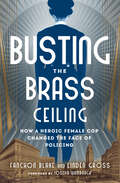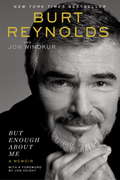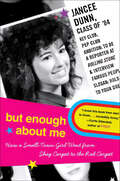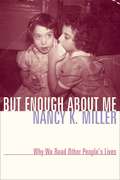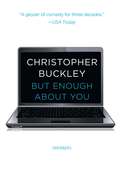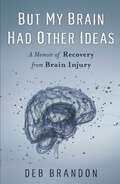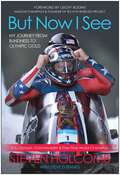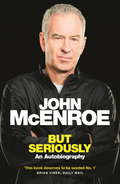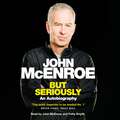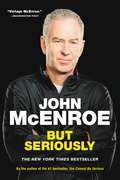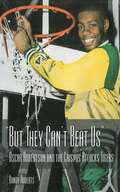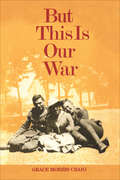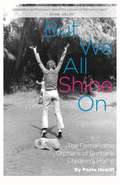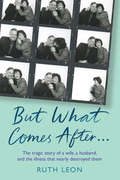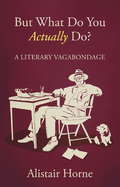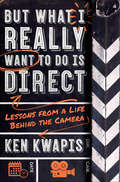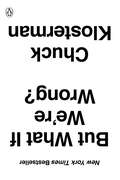- Table View
- List View
Busting the Brass Ceiling: How a Heroic Female Cop Changed the Face of Policing
by Linden Gross Fanchon BlakeA policewoman chronicles her historic legal battle against sexism within the LAPD in this &“valuable . . . and at times, frightening&” memoir (Kirkus Reviews). Former Army major Fanchon Blake dreamed of becoming a top cop. She joined the LAPD in 1948, confident that her efforts and talent would be rewarded. Instead, despite long hours and high achievement ratings, Blake—like all other women on the force—was denied promotion time and again. Over the years, the tenacious officer challenged the LAPD&’s discriminatory agenda from within. Eventually, she broke the &“blue wall of silence&” by going to the press. And when all else failed, Blake saw one last chance to effect change: she filed a complaint against the LAPD with the federal Equal Employment Opportunity Commission in 1973. What followed was a harrowing struggle against discrimination that would make history for women and other minority groups. Despite the ensuing verbal abuse, silent treatment, and intimidation, Blake pushed on. Seven years later, her heroic efforts would finally make it possible for women to bust through the brass ceiling.
Busy Being Free: A Lifelong Romantic is Seduced by Solitude
by Emma Forrest'A staggering piece of writing' Nigella Lawson'It's woken me up' Minnie Driver, author of Managing Expectations'The most delicious memoir that kept me in bed all day' Sophie Heawood, author of The Hungover GamesWhat happens when your story doesn't end the way you thought it would? When the dream life you have been working towards becomes something you must walk away from? When you swap a Hollywood marriage and a LA mansion with waterside views, for a little attic flat shared only with your daughter, beneath the star-filled sky of deepest North London? When you find yourself not lonely, but elated - elated to be alone with yourself, who you genuinely thought you might never get to see again? When, after a life guided by romantic obsession, you decide to turn your back not only on marriage, but all romantic and sexual attachments?
Busy Being Free: A Lifelong Romantic is Seduced by Solitude
by Emma Forrest'A staggering piece of writing' Nigella Lawson'It's woken me up' Minnie Driver, author of Managing Expectations'The most delicious memoir that kept me in bed all day' Sophie Heawood, author of The Hungover GamesWhat happens when your story doesn't end the way you thought it would? When the dream life you have been working towards becomes something you must walk away from? When you swap a Hollywood marriage and a LA mansion with waterside views, for a little attic flat shared only with your daughter, beneath the star-filled sky of deepest North London? When you find yourself not lonely, but elated - elated to be alone with yourself, who you genuinely thought you might never get to see again? When, after a life guided by romantic obsession, you decide to turn your back not only on marriage, but all romantic and sexual attachments?
But Enough About Me
by Jon Winokur Burt ReynoldsScandalous, sentimental, frank, and sincere--the ultimate inside account of a television and film icon.Burt Reynolds has been a Hollywood leading man for six decades, known for his legendary performances, sex-symbol status, and storied Hollywood romances. In his long career of stardom, during which he was number one at the box office for five years in a row, Reynolds has seen it all. But Enough About Me will tell his story through the people he's encountered on his amazing journey. In his words, he plans to "call out the assholes," try to make amends for "being the asshole myself on too many occasions," and pay homage to the many heroes he has come to love and respect.Beginning with Reynolds's adolescence as a notable football player and the devastating car accident that ended his sports career, But Enough About Me takes readers from the Broadway stages where Reynolds got his start to his subsequent rise to fame. From Oscar nominations, to the spread in Cosmopolitan magazine that remains a notorious pop-cultural touchstone to this day, to the financial decisions that took him from rich to poor and back again, Reynolds shares the wisdom that has come from his many highs and lows. He is also ready, now more than ever, to dish. Reynolds famously romanced Dinah Shore, Sally Field, and Loni Anderson, to name only the top few; batted eyes at Bette Davis, Greta Garbo, Goldie Hawn, Farrah Fawcett, Marilyn Monroe, Candice Bergen, and so many more; went a few rounds (or more) with the likes of Donald Trump and Helen Gurley Brown; and rubbed elbows with Jon Voight, Clark Gable, Clint Eastwood, Frank Sinatra, Orson Welles, Mel Brooks, Woody Allen, and Johnny Carson, among many others. Through it all, Reynolds reflects on his personal pitfalls and recoveries and refocuses his attention on his legacy as a father and an acting teacher, leaving readers with a classic from one of Hollywood's most enduring and treasured stars.
But Enough About Me
by Jon Winokur Burt ReynoldsScandalous, sentimental, frank, and sincere--the ultimate inside account of a television and film icon.Burt Reynolds has been a Hollywood leading man for six decades, known for his legendary performances, sex-symbol status, and storied Hollywood romances. In his long career of stardom, during which he was number one at the box office for five years in a row, Reynolds has seen it all. But Enough About Me will tell his story through the people he's encountered on his amazing journey. In his words, he plans to "call out the assholes," try to make amends for "being the asshole myself on too many occasions," and pay homage to the many heroes he has come to love and respect.Beginning with Reynolds's adolescence as a notable football player and the devastating car accident that ended his sports career, But Enough About Me takes readers from the Broadway stages where Reynolds got his start to his subsequent rise to fame. From Oscar nominations, to the spread inCosmopolitan magazine that remains a notorious pop-cultural touchstone to this day, to the financial decisions that took him from rich to poor and back again, Reynolds shares the wisdom that has come from his many highs and lows. He is also ready, now more than ever, to dish. Reynolds famously romanced Dinah Shore, Sally Field, and Loni Anderson, to name only the top few; batted eyes at Bette Davis, Greta Garbo, Goldie Hawn, Farrah Fawcett, Marilyn Monroe, Candice Bergen, and so many more; went a few rounds (or more) with the likes of Donald Trump and Helen Gurley Brown; and rubbed elbows with Jon Voight, Clark Gable, Clint Eastwood, Frank Sinatra, Orson Welles, Mel Brooks, Woody Allen, and Johnny Carson, among many others. Through it all, Reynolds reflects on his personal pitfalls and recoveries and refocuses his attention on his legacy as a father and an acting teacher, leaving readers with a classic from one of Hollywood's most enduring and treasured stars.From the Hardcover edition.
But Enough About Me: How a Small-Town Girl Went from Shag Carpet to the Red Carpet
by Jancee Dunn“Breezy . . . juicy . . . irresistible” this memoir from a former Rolling Stone reporter is “as entertaining as the megastars she has built a career on profiling” (Entertainment Weekly).New Jersey in the 1980s had everything Jancee Dunn wanted: trips down the shore, Bruce Springsteen, a tantalizing array of malls, and, especially, her family. But one night she met a girl who worked at Rolling Stone magazine in New York City. To Jancee, who visited the city exactly once a year, New York might as well have been in Canada. But she loved music, so she passed along her résumé.Soon Jancee was behind the scenes, interviewing some of the most famous people in the world, among them Madonna, Cameron Diaz, and Beyoncé. She trekked to the Canadian Rockies to hike with Brad Pitt, was chased by paparazzi who mistook her for Ben Affleck’s new girlfriend, snacked on Velveeta with Dolly Parton, and danced drunkenly onstage with the Beastie Boys. She even became a TV star as a pioneering VJ on MTV2.As her life spun faster, she traded her good-girl suburban past for late nights and hipster guys. But then a chance meeting turned Jancee’s life in an unexpected direction and helped her to finally learn to appreciate where she came from, who she was, and what she wanted to be.Hilarious and touching, But Enough About Me is the story of an outsider who couldn’t quite bring herself to become an insider and introduces readers to a lovable real-life heroine.“An inside look at being a celebrity journalist.” —New Yorker“Disarmingly funny.” —People“Relentlessly readable.” —New York Magazine“Pitch-perfect.” —Vogue
But Enough About Me: Why We Read Other People's Lives (Gender and Culture Series)
by Nancy K. MillerIn her latest work of personal criticism, Nancy K. Miller tells the story of how a girl who grew up in the 1950s and got lost in the 1960s became a feminist critic in the 1970s. As in her previous books, Miller interweaves pieces of her autobiography with the memoirs of contemporaries in order to explore the unexpected ways that the stories of other people's lives give meaning to our own. The evolution she chronicles was lived by a generation of literary girls who came of age in the midst of profound social change and, buoyed by the energy of second-wave feminism, became writers, academics, and activists. Miller's recollections form one woman's installment in a collective memoir that is still unfolding, an intimate page of a group portrait in process.
But Enough About You: Essays
by Christopher BuckleyChristopher Buckley at his best: an extraordinary, wide-ranging selection of essays both hilarious and poignant, irreverent and delightful.In his first book of essays since his 1997 bestseller, Wry Martinis, Buckley delivers a rare combination of big ideas and truly fun writing. Tackling subjects ranging from "How to Teach Your Four-Year-Old to Ski" to "A Short History of the Bug Zapper," and "The Art of Sacking" to literary friendships with Joseph Heller and Christopher Hitchens, he is at once a humorous storyteller, astute cultural critic, adventurous traveler, and irreverent historian. Reading these essays is the equivalent of being in the company of a tremendously witty and enlightening companion. Praised as "both deeply informed and deeply funny" by The Wall Street Journal, Buckley will have you laughing and reflecting in equal measure.
But Everyone Feels This Way: How an Autism Diagnosis Saved My Life
by Paige LayleAutism acceptance activist and TikTok influencer Paige Layle shares her deeply personal journey to diagnosis and living life autistically. &“For far too long, I was told I was just like everyone else. But knew it couldn&’t be true. Living just seemed so much harder for me. This wasn&’t okay. This wasn&’t normal. This wasn&’t functioning. And it certainly wasn&’t fine.&” Paige Layle was normal. She lived in the countryside with her mom, dad, and brother Graham. She went to school, hung out with friends, and all the while everything seemed so much harder than it needed to be. A break in routine threw off the whole day. If her teacher couldn't answer &“why&” in class, she dissolved into tears, unable to articulate her own confusion or explain her lack of control. But Paige was normal. She smiled in photos, picked her feet up when her mom needed to vacuum instead of fleeing the room, and earned high grades. She had friends and loved to perform in local theater productions. It wasn&’t until a psychiatrist said she wasn&’t doing okay, that anyone believed her. In But Everyone Feels This Way, Paige Layle shares her story as an autistic woman diagnosed late. Armed with the phrase &“Autism Spectrum Disorder&” (ASD), Paige challenges stigmas, taboos, and stereotypes while learning how to live her authentic, autistic life.
But Everyone Feels This Way: How an Autism Diagnosis Saved My Life
by Paige LayleIn But Everyone Feels This Way, Autism acceptance activist and multi-million-follower TikTok influencer Paige Layle shares her deeply personal journey to diagnosis and living life autistically. It all started out pretty normal: Paige lived in the countryside with her parents and brother Graham. She went to school, hung out with friends, and all the while everything seemed so much harder than it needed to be. A break in routine threw off the whole day. If her teacher couldn't answer 'why?' in class, she dissolved into tears, unable to articulate her own confusion or explain her lack of control. But Paige was normal. She smiled in photos, picked her feet up when her mum needed to vacuum instead of fleeing the room, and did well at school. She was popular and well-liked. And until she had a full mental breakdown, no one believed her when she claimed that she was not okay.Women are frequently diagnosed with autism much later than men, often in their late teens or early twenties. Armed with her new diagnosis, Paige set out to learn how to live her authentic, autistic life, and discovered how autism could be a source of strength. She challenges stigmas, taboos, and stereotypes so that everyone can see themselves authentically. Along the way, her online activism has spread awareness, acceptance, and self-recognition in millions of others.
But Everyone Feels This Way: How an Autism Diagnosis Saved My Life
by Paige LayleIn But Everyone Feels This Way, Autism acceptance activist and multi-million-follower TikTok influencer Paige Layle shares her deeply personal journey to diagnosis and living life autistically. It all started out pretty normal: Paige lived in the countryside with her parents and brother Graham. She went to school, hung out with friends, and all the while everything seemed so much harder than it needed to be. A break in routine threw off the whole day. If her teacher couldn't answer 'why?' in class, she dissolved into tears, unable to articulate her own confusion or explain her lack of control. But Paige was normal. She smiled in photos, picked her feet up when her mum needed to vacuum instead of fleeing the room, and did well at school. She was popular and well-liked. And until she had a full mental breakdown, no one believed her when she claimed that she was not okay.Women are frequently diagnosed with autism much later than men, often in their late teens or early twenties. Armed with her new diagnosis, Paige set out to learn how to live her authentic, autistic life, and discovered how autism could be a source of strength. She challenges stigmas, taboos, and stereotypes so that everyone can see themselves authentically. Along the way, her online activism has spread awareness, acceptance, and self-recognition in millions of others.
But My Brain Had Other Ideas: A Memoir of Recovery from Brain Injury
by Deb Brandon2017 USA Best Book Awards Finalist in Autobiography/Memoir When Deb Brandon discovered that cavernous angiomas—tangles of malformed blood vessels in her brain—were behind the terrifying symptoms she'd been experiencing, she underwent one brain surgery. And then another. And then another. And that was just the beginning. The book also includes an introduction by Connie Lee, founder and president of the Angioma Alliance. Unlike other memoirs that focus on injury crisis and acute recovery, But My Brain Had Other Ideas follows Brandon&’s story all the way through to long-term recovery, revealing without sugarcoating or sentimentality Brandon&’s struggles—and ultimate triumph.
But Now I See: My Journey from Blindness to Olympic Gold
by Steve Eubanks Steven HolcombOne of the top bobsledders in the world and leader of the four-man American team, Steven Holcomb had finished sixth in the 2006 Olympics and medaled in nearly every competition he entered. He was considered a strong gold contender for the 2010 Vancouver Olympic Winter Games. Talented, aggressive, and fearless, he was at the top of his game. But Steven Holcomb had a dangerous secret. Steven Holcomb was going blind. In the prime of his athletic career, he was diagnosed with keratoconus—a degenerative disease affecting 1 in 1,000 and leaving 1 in 4 totally blind without a cornea transplant. In the world of competitive sports, it was a dream killer. Not a sport for the timid, bobsledding speeds approach 100 miles per hour through a series of hairpin turns. Serious injuries—even deaths—can result. But Holcomb kept his secret from his coach, sled mates, and the public for months and continued to drive the legendary sled The Night Train. When he finally told his coach, Holcomb was led to a revolutionary treatment, later named the Holcomb C3-R. With his sight restored to 20/20, Holcomb became the first American in 50 years to win the International Bobsled and Skeleton Federation World Championship, and the first American bobsledder since 1948 to win the Olympic gold medal. With a foreword by Geoff Bodine, NASCAR champion and founder of the Bo-Dyn Bobsled Project, But Now I See is the intimate portrait of a man's pursuit of a dream, laced with humility and the faith to find a way when all seems hopeless. It's about knowing anything is possible and the gift of a second chance.
But Seriously: An Autobiography
by John McEnroeThe wildly entertaining Sunday Times bestseller'This book deserves to be seeded No. 1' Daily MailFifteen years after his massive bestseller Serious, John McEnroe is back and ready to talk.Who are the game's winners and losers? What's it like playing guitar onstage with the Rolling Stones, hitting balls with today's greats, breaking bread with his former on-court nemeses, getting scammed by an international art dealer, and raising a big family while balancing McEnroe-sized expectations?But Seriously is a richly personal account, blending anecdote and reflection with razor sharp and brutally honest opinions. This is the sports book of the year: brilliantly funny, surprisingly touching, and 100% McEnroe.
But Seriously: An Autobiography
by John McEnroeRead by John McEnroe and Patty Smyth'The follow up volume to 2002's best-selling Serious, and every bit as entertaining' DAILY MAIL'Who can forget the shouty bad boy, infamous for his temper! Now a respected elder statesman of tennis, his fascinating memoir reveals all' BESTHe is one of the most controversial sportsmen in history and a legend of Open Era tennis. But after reaching the top of his game - what came next? A decade after his international number-one bestseller SERIOUS, John McEnroe is back and ready to talk.Now the undisputed elder statesman of tennis, McEnroe has won over his critics as a matchless commentator and analyst at Wimbledon and other Grand Slam tournaments - with outspoken views on the modern game and its top players. He has continued to compete on the court, winning the ATP Champions Tour a record six times, and has travelled the globe to play in charity events. More surprising have been the calls from TV producers, inviting John to riff on his famous hot temper in cult shows such as 30 ROCK and CURB YOUR ENTHUSIASM. And then there is his long-standing passion for American contemporary art.In BUT SERIOUSLY John McEnroe confronts his demons and reveals his struggle to reinvent himself from ex-champion to father, broadcaster and author. The result is a richly personal account, blending anecdote and reflection in an inspirational re-evaluation of what it means to be - and stay - successful.(p) 2017 Hachette Audio
But Seriously: An Autobiography
by John McenroeJohn McEnroe's long-awaited follow-up to his #1 bestsellerHe is one of the most controversial and beloved athletes in history, a tennis legend and a volcanic, mesmerizing presence. But after reaching the top of his game - what came next? Fifteen years after his international number-one bestseller You Cannot Be Serious, John McEnroe is back and ready to talk.Now the undisputed elder statesman of tennis, McEnroe has won over his critics as a brilliant commentator at the US Open, Wimbledon, and other Grand Slam tournaments - with outspoken views on the modern game, its top players, and the world of 21st century sport and celebrity. Who are the game's winners and losers? What's it like playing guitar onstage with the Rolling Stones, hitting balls with today's greats, confronting his former on-court nemeses, getting scammed by an international art dealer, and raising a big family while balancing McEnroe-sized expectations?In But Seriously, John McEnroe confronts his demons and reveals his struggle to reinvent himself from champion and tennis legend to father, broadcaster, and author. The result is a richly personal account, blending anecdote and reflection with razor sharp and brutally honest opinions, all in McEnroe's signature style. This is the sports book of the year: wildly entertaining, very funny, surprisingly touching, and 100% McEnroe.
But They Can't Beat Us: Oscar Robertson and the Crispus Attucks Tigers
by Randy RobertsThe Crispus Attucks High School basketball teams of 1955 and 1956 made Indiana basketball history as the first all-black team to win a state championship and then as the first undefeated team ever to win the championship. The story of Oscar Robertson's dedication to the game and of the unforgettable Attucks teams of the 1950s are told in this inspiring book that brings together race, joy, and achievement during a critical time in Indiana and American history.
But This is Our War
by Grace Morris CraigPembroke. August 4, 1914. On a verandah in town four young people anxiously await news that will change irrevocably the course of their lives. A fifth arrives, out of breath, with the latest bulletin from the telegraph office. War has been declared – and it is their war. At the age of ninety, Grace Craig looks back to her youth and tells the story of the impact of the Great War on her family and friends. Letters from the young men on the Western Front are interwoven with her own memories of the war. Her brother Basil, youngest officer in the No. 1 Canadian Tunnelling Company, fights underground driving mineshafts deep below the tortured earth of no man's land; later, as an observer in the Royal Flying Corps, he flies above the enemy lines amidst the bursting shells. His older brother Ramsey, a lieutenant in the 38th Battalion, fights in the constant mud on the ground, and must lead his men 'over the top' in the face of enemy fire. At home their sister knits socks and scarves, packs boxes to be sent overseas, serves vast quantities of apple pie and ice cream in the canteen at nearby Camp Petawa, and leads the assembled troops in stirring war songs. In November 1916 she braves the U boats and the North Atlantic to spend time with her brothers while they are on leave in England. Divided by danger and distance, letters alone allowed contact. The soldiers yearned for everyday news of home; and in Pembroke one waited for, and kept forever, those precious scraps of paper from beyond the sea. But This is Our War is a moving, absorbing document of young Canadians at war.
But We All Shine On: The Remarkable Orphans of Burbank Children's Home
by Paolo Hewitt'We orphans are the most important kids in the world.' Stepping into the past, Paolo Hewitt embarks upon an inspiring journey to track down a group of friends he grew up with at Burbank Children's Home. We meet Des, the boy who reinvented himself; Norman, the runaway child who crossed a continent; David, the boy who couldn't be heard; and Terry, the child who sat in a school field for four days. Paolo brings to life the struggles and triumphs of adults navigating life after care, and discovers many things: about himself, about care, but most of all about the indomitable force of the human spirit - even in the face of overwhelming odds. But We All Shine On is a worthy companion to Paolo Hewitt's classic memoir The Looked After Kid: My Life in a Children's Home.
But What Comes After?
by Ruth LeonRuth Leon was married to Sheridan Morley - theatre critic, broadcaster and Britain's pre-eminent arts journalist. He'd suffered from bouts of depression all his life but suddenly, after a mild stroke, his usual treatments stopped working. He sat, crying, his chin pressed down into his chest, all day, every day. Ruth looked after him - sometimes gracefully and sympathetically, often angrily and tensely. Also an arts journalist, for two years she did her own freelance work as well as his. She no longer recognised her husband, but she could be him. One day, a consultant in Oxford said he thought they'd been treating the wrong kind of depression; that the stroke had damaged the emotional centre of Sheridan's brain. He knew of a procedure that might help, but it had never before been performed in the UK. It was an outlandish, fantastical idea - an implant would be put in Sheridan's brain that would allow doctors to adjust his mood with an electronic remote control. They would be tampering with the very core of what made Sheridan Sheridan. On behalf of her long-absent husband, Ruth agreed.Ruth Leon's account of this unique journey to the heart of what it is to be human is as honest and moving as it is fascinating and challenging.
But What Comes After?
by Ruth LeonRuth Leon was married to Sheridan Morley - theatre critic, broadcaster and Britain's pre-eminent arts journalist. He'd suffered from bouts of depression all his life but suddenly, after a mild stroke, his usual treatments stopped working. He sat, crying, his chin pressed down into his chest, all day, every day. Ruth looked after him - sometimes gracefully and sympathetically, often angrily and tensely. Also an arts journalist, for two years she did her own freelance work as well as his. She no longer recognised her husband, but she could be him. One day, a consultant in Oxford said he thought they'd been treating the wrong kind of depression; that the stroke had damaged the emotional centre of Sheridan's brain. He knew of a procedure that might help, but it had never before been performed in the UK. It was an outlandish, fantastical idea - an implant would be put in Sheridan's brain that would allow doctors to adjust his mood with an electronic remote control. They would be tampering with the very core of what made Sheridan Sheridan. On behalf of her long-absent husband, Ruth agreed.Ruth Leon's account of this unique journey to the heart of what it is to be human is as honest and moving as it is fascinating and challenging.
But What Do You Actually Do?: A Literary Vagabondage
by Alistair HorneThis wonderfully entertaining journey takes us from Alistair Horne's childhood as a wartime evacuee in America to his career as a highly successful historian and biographer, via a stint as a foreign correspondent for the Daily Telegraph. We travel with him from Germany to America, from Canada to France, from Latin America to the Middle East. A consummate biographer, the pages of Horne's 'Literary Vagabondage' abound with vivid character sketches of the friends and foes that have shaped his life.
But What Do You Actually Do?: A Literary Vagabondage
by Sir Alistair Horne CBEThis wonderfully entertaining journey takes us from Alistair Horne's childhood as a wartime evacuee in America to his career as a highly successful historian and biographer, via a stint as a foreign correspondent for the Daily Telegraph. We travel with him from Germany to America, from Canada to France, from Latin America to the Middle East. A consummate biographer, the pages of Horne's 'Literary Vagabondage' abound with vivid character sketches of the friends and foes that have shaped his life.
But What I Really Want to Do Is Direct: Lessons from a Life Behind the Camera
by Ken KwapisFor over three decades, director Ken Kwapis has charted a career full of exceptional movies and television, from seminal shows like The Office to beloved films like He’s Just Not That Into You.He is among the most respected directors in show business, but getting there wasn’t easy. He struggled just like everyone else. With each triumph came the occasional faceplant. Using his background and inside knowledge, But What I Really Want To Do is Direct tackles Hollywood myths through Ken’s highly entertaining experiences. It’s a rollercoaster ride fueled by brawls with the top brass, clashes over budgets, and the passion that makes it all worthwhile.This humorous and refreshingly personal memoir is filled with inspiring instruction, behind-the-scenes hilarity, and unabashed joy. It’s a celebration of the director’s craft, and what it takes to succeed in show business on your own terms. "Ken Kwapis always brought out the best in the actors on The Office. Whenever Ken was directing, I always felt safe to go out on a limb and take chances, knowing he had my back. Every aspiring director should read this book. (I can think of several 'professional' directors that should read it too!)" -Jenna Fischer"A vital, magnificent manifesto on the art and craft of directing, written with emotional, instinctual and intellectual depth by one of America's most beloved film and television directors" -Amber Tamblyn"In the years that I was fortunate to work with Ken on Malcolm in the Middle, he had an uncanny ability to guide actors right to the heart of a scene and reveal its truths. He admits that he doesn’t have all the answers, he’ll make mistakes, and at times he’ll struggle, but as he says in the book, 'It’s the struggle to get it right that makes us human.'" -Bryan Cranston"Good luck finding a more kind, passionate, and talented director alive than Ken. Seriously, good luck." -Tig Notaro“'Action!' is what most directors bark out to begin a scene. But Ken Kwapis starts by gently intoning the words 'Go ahead…' That simple suggestion assures everyone they’re in smart, capable, humble hands. That’s how you’ll feel reading this book. And so, if you’re anxious to discover how a top director always brings humor, honesty, and humanity to his work, all I can tell you is…Go ahead." -Larry Wilmore
But What If We're Wrong?: Thinking About the Present As If It Were the Past
by Chuck Klosterman<P>We live in a culture of casual certitude. This has always been the case, no matter how often that certainty has failed. Though no generation believes there's nothing left to learn, every generation unconsciously assumes that what has already been defined and accepted is (probably) pretty close to how reality will be viewed in perpetuity. And then, of course, time passes. Ideas shift. Opinions invert. What once seemed reasonable eventually becomes absurd, replaced by modern perspectives that feel even more irrefutable and secure--until, of course, they don't. <P>But What If We're Wrong? visualizes the contemporary world as it will appear to those who'll perceive it as the distant past. Chuck Klosterman asks questions that are profound in their simplicity: How certain are we about our understanding of gravity? How certain are we about our understanding of time? What will be the defining memory of rock music, five hundred years from today? How seriously should we view the content of our dreams? How seriously should we view the content of television? Are all sports destined for extinction? Is it possible that the greatest artist of our era is currently unknown (or--weirder still--widely known, but entirely disrespected)? Is it possible that we "overrate" democracy? And perhaps most disturbing, is it possible that we've reached the end of knowledge? <P>Kinetically slingshotting through a broad spectrum of objective and subjective problems, But What If We're Wrong? is built on interviews with a variety of creative thinkers--George Saunders, David Byrne, Jonathan Lethem, Kathryn Schulz, Neil deGrasse Tyson, Brian Greene, Junot Díaz, Amanda Petrusich, Ryan Adams, Nick Bostrom, Dan Carlin, and Richard Linklater, among others--interwoven with the type of high-wire humor and nontraditional analysis only Klosterman would dare to attempt. <P>It's a seemingly impossible achievement: a book about the things we cannot know, explained as if we did. It's about how we live now, once "now" has become "then." <P><b>A New York Times Bestseller</b>
